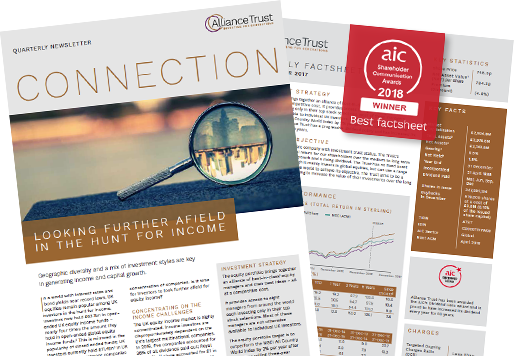Balancing act: securing income and growth
1966 is a year synonymous with many things, the space race, Geoff Hurst’s extra-time goal and The Beatles’ last tour being among them. A rather less well-known fact, but still significant for Alliance Trust investors, is that 1966 also marked the beginning of an impressive and proud record for the company.
Jump forward to today and Alliance Trust has increased its dividend for 53 consecutive years since 1966 – one of only a handful of investment trusts to have achieved a rising dividend for more than half a century. It is a notable and proud achievement, and a position that Willis Towers Watson, the Trust’s investment manager, intends to maintain. We may have been leading the refreshed investment strategy for approaching three years, but we understand the importance of this dividend for shareholders, particularly those who rely on us to provide a steady income during retirement, for example.
Income versus growth
In the wider investment world, often we can risk becoming too singular in our focus. Investors are quizzed on whether they are seeking ‘income’ or ‘growth’ from their portfolio, yet we argue, why not both?
When interest rates are at near historic lows, it may be tempting to seek out a high-yielding trust that will bump up your savings pot with rocketing dividend payments. This is all fair enough when times are good, but it is far more important to understand the sustainability of the dividend payments, particularly if we were to enter more difficult market conditions.
Similarly, a sole focus on capital growth and a rising share price can also lead to an investor being blindsided by impressive performance figures that, while strong in the short term, mean very little if the growth is countered by weakness over a longer period.
Some may look to extreme NAV growth as a sign of the health or success of a trust – but the need for a reliable, steady income stream should not be underestimated. One of the key benefits of the investment trust structure, is the ability to hold up to 15% of profits back in reserve, allowing us to build up cash in strong growth years, in order to maintain steady income payments in years that corporate profits may come under pressure.
Dividend payments are not just for income-seekers; as the numbers above show, they can have significant effects on the growth of your total por t folio.
Alliance Trust’s ‘rainy day fund’ is significant, meaning we are well prepared for any potential pressure. Dividends can also be an important contributor to the growth of a savings pot, as the compounding effect of reinvesting dividend payments can have a huge impact on a portfolio over the years.
The power of compounding
Looking at total return – performance that takes into account both capital returns as well as if dividends were reinvested – and we can see the power of putting dividend payments to work by reinvesting them into Alliance Trust.
Over the last 20 years, a £1,000 investment with the dividends reinvested would have grown to £4,420, according to analysis by Willis Towers Watson. A £10,000 investment would have grown to £44,200.
Looking over an even longer period, back to 1967 and the time when Alliance Trust’s consecutive dividend increases first began, the compounding effect is even more evident. A £1,000 investment made in 1967 would be worth £199,320 today if dividends were reinvested, while a £10,000 pot would now be worth a very impressive £1.9m.
Dividend payments are not just for income-seekers; as the numbers above show, they can have significant effects on the growth of your total portfolio.
Speaking as the investment manager of the Alliance Trust global equity portfolio, steadily rising dividend payments will remain one of our key priorities. Shooting the lights out with double-digit performance in the short term is not the aim. Of course we want to outperform wider markets, but we want to be confident that we can secure steady capital growth, as well as a stable, rising dividend, over the long term.








